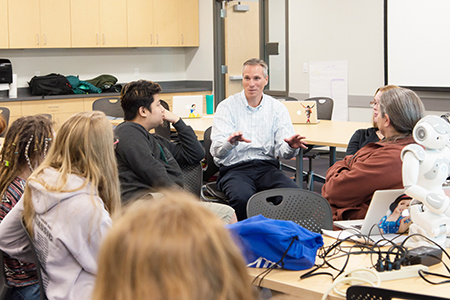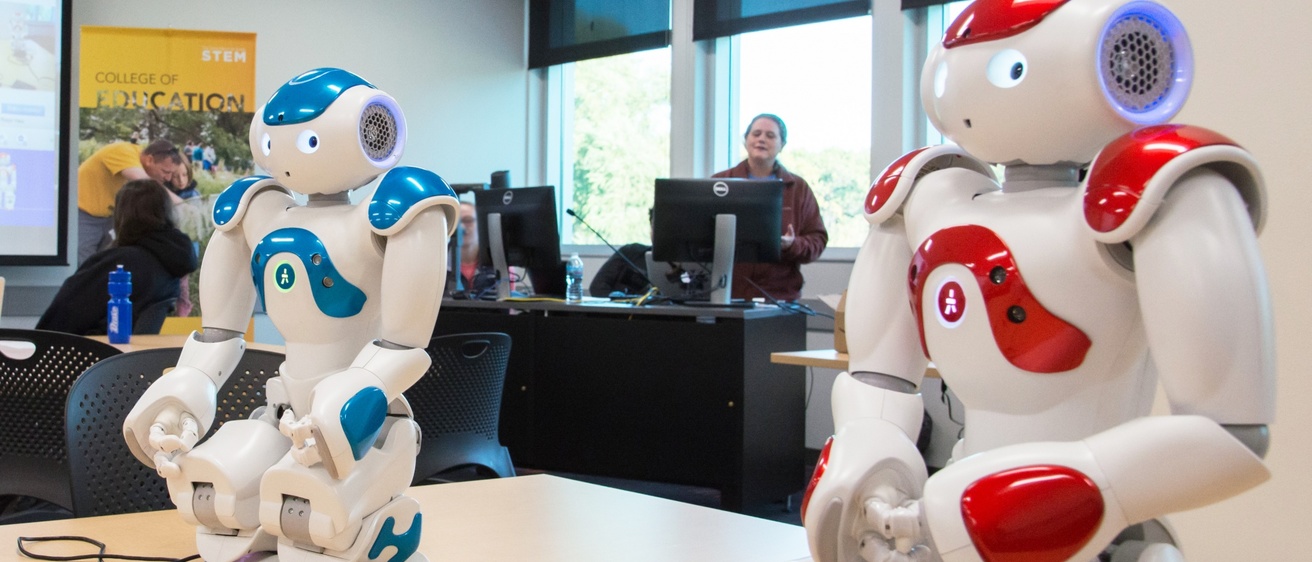By Andy Goodell
The intelligence of human beings may be complemented by that of the artificial variety found in robots. Discussing potential methods of harnessing this relationship in the world of education is one focus of the Topics in Education course taught at the Kirkwood Regional Center at the University of Iowa.
Mark McDermott, clinical associate professor in Science Education at the University of Iowa College of Education, leads this class, which is designed to spark the imaginations of area high school students considering entering the education field. McDermott also serves as STEM Coordinator for the UI College of Education.
During a recent Topics in Education class, students created a dialog about the possible role of artificially intelligent robots in an education setting and beyond, thanks to the assistance of Denise Szecsei, a lecturer in the Math and Computer Science departments in the University of Iowa College of Liberal Arts and Sciences. Szecsei brought three robots to the classroom, explaining that the students could work in groups to essentially write debate speeches for one of the two robots, with the third machine serving as moderator. After breaking into small groups, each assigned one of the debating robots, students were asked to answer three debate questions, which would serve as their candidate robot’s stance on a certain issue related to artificial intelligence (AI).
The resulting debate demonstrated the students’ acumen as critical thinkers, creating an enriching experience for all. The discussion that followed the mock debate found students diving into what it could mean for AI to be used in the classroom and in other facets of education, such as school counseling.
“It’s not just the kids are excited because of the robots,” says McDermott. “The kids are learning from the experience.”
Hannah Siewert, a senior at Clear Creek Amana High School in Tiffin, says she thought the robot debate was incredible. Siewert was excited to learn about the robots themselves and was especially impressed when the machines spoke the students' debate scripts.
“While writing the scripts, I heard many students discussing the current presidential candidates,” says Siewert. “It's cool how a topic that most of us usually find unexciting was turned into a thought-provoking experience.”
The fun factor of the mock debate was meant to spark interest in students so they could imagine how AI could be used in classrooms of the not-too-distant future. Specifically, students were asked to think about how AI could meet teaching goals that may be unattainable if not for AI technology.
“It’s a conduit for the kids to develop their own thoughts and their own critical thinking skills and their own analysis skills that maybe we wouldn’t have been able to do had we not had the technology there to sort of facilitate that,” says McDermott.
Szecsei says the mock debate is also meant to get young people interested in computer science and algorithmic thinking as well as to have them consider what technological innovations can be brought into the classroom.
“She’s using this technology, which I would consider an aspect of STEM, to help the kids learn about a social studies type of issue,” explained McDermott, noting the mock debate’s similarity to real-life political debates. “It’s a good example of how technology can a lot of times be the component of STEM that helps integrate STEM into other content areas.”

Siewert says she believes technology is very important for education, noting that each student learns differently and that technology can adapt to these learning styles, which would foster greater student involvement.
“One of the purposes of education is to prepare students for their future,” explained Siewert. “By including technology in the classroom, students will become more tech savvy and will be better prepared for the real world, which is full of technology.”
There is a real team aspect to preparing the mock robot debate that helps integrate many areas of learning beyond that which is under the umbrella of STEM. Szecsei says students who are drawn to writing or theater could become interested in areas of STEM through the mock debate because it shows them how the world of computer programming can be brought into language arts and performance art.
With the robots, Szecsei says there are many layers to what the students in McDermott’s class are learning. A language arts aspect is brought about by having students author the responses to debate questions the robots recite. An element of theatrical performance is there when the students consider how to deliver a particular message. And, there’s an element of programming through working with the software interface that operates the robots. Perhaps most important to note about this process is that students are not just consuming technology – they’re creating it.
“So, by continuing to get kids into programming at a younger age, they will be able to build on their experiences and create more and more ambitious projects as their writing and communication skills develop. They will have a better understanding of how technology can be used to augment their work in other areas,” says Szecsei.
The Topics in Education class allows for many different speakers from the University of Iowa and elsewhere to interact with students who are interested in potentially going into the field of education. This way, they can be shown the many opportunities that exist within education from becoming a teacher to working in higher education or school counseling and beyond.
“It’s a great opportunity for high school students to realize ‘A: there’s a huge variety of areas I can go into in education’ and ‘B: there’s a lot of exciting things going on here at the College of Education right here in Iowa City,’” says McDermott.
